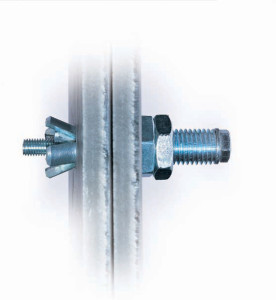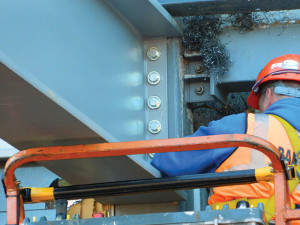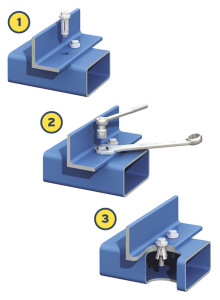Connecting to steel hollow structural sections (HSS) from a single side has troubled engineers for decades. However, there are now numerous types of fasteners and connection methods for this increasingly popular structural material, other than the norm of welding. This article will look at the benefits and drawbacks of each connection method, to find that expansion bolts for HSS members are a viable option.
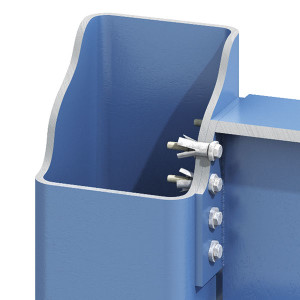
Figure 1. A 3D model illustrates a structural connection and shows how the bolt expands inside the HSS section.
Often when a designer has opted to use HSS for its bi-axial capacity or the aesthetics of visually appealing symmetric shapes, the question that arises is how to attach another structural member to it. Most often with structural shapes, welding or bolting has been the preferred method as they can handle a high degree of load. But when there exists restrictions in welding or where engineers want to avoid the high costs of labor involved with certified welders, setup, breakdown charges and having to fire protect the surrounding area, engineers turn to mechanical fasteners to get the job done.
The American Institute of Steel Construction (AISC) addresses HSS connections in their Design Guide 24–Hollow Structural Section Connections. Within that document, they refer to Part 7 of the AISC manual Special Considerations for Hollow Structural Sections, which discusses various mechanical fasteners that can be used for HSS connections. These include:
Through-Bolts are commonly used, but the inherent flexibility of HSS walls typically prevents the use of pre-tensioned fasteners without additional fabrication work, such that joints tend to be designed for static shear only. It also makes connections to opposing faces of a square or rectangular HSS member difficult and time-consuming to assemble on site. In many cases, stiffeners may have to be welded inside the tube to give it extra support, which would incur an extra cost of shop welding.
Threaded Studs can be used on the faces of HSS members, although heavy and unwieldy equipment will have to be used in the form of a weld gun and associated equipment. This will require the same considerations as welding the members together in the first place. This is a process that can be done ahead of time in the fabrication shop before it is sent to the field. In some instances, recessed or counter-bored holes might be necessary to clear the collar that could form where the stud meets the HSS face. The finished product will produce the appearance of a bolted connection but made on only one side of the HSS.
Flow or friction-drilling is a method of forming a screw thread within thin material, like sheet metal, using tools that rotate at high speed. The process reshapes the material so that none is lost, with the excess forming a sleeve that is longer than the original thickness of the material, making it possible to create a relatively strong joint in thin material. Unfortunately, friction drilling is not possible in material thicker than about half the hole diameter; and the material must be able to withstand the heat produced, which means that sections that have already been painted or galvanized are often unsuitable and require touch-up. Field installations are only recommended for thicknesses less than or equal to 5/16 inch, and will also require additional field equipment and tools.
Blind bolting covers a variety of fasteners that are attached to the HSS from one side only. The majority of blind bolting products are proprietary fasteners, which come in many different shapes and sizes. Per AISC, there is no empirical way of calculating load values for many of these products and, therefore, AISC suggests engineers refer to manufacturers’ literature. Manufacturers therefore have developed bolt strengths via testing and statistical analysis to determine their published values. However, the increased popularity of expansion bolts for structural steel has led to the recent publication of International Code Council’s (ICC) evaluation reports. These independent reports verify third party testing and provide applicable load values that are consistent with the intent of the International Building Code (IBC).
The following explores the many types of ‘blind’ fasteners:
Singled sided structural fasteners are claimed to have high breaking loads; however, they generally consist of individual parts and require a specific installation tool. The number of separate parts means that installation can be a longer-than-expected process. In certain circumstances, the tool may require reversing to aid the tightening process, further extending the installation time. Other bolts are available which are claimed to be equally as good, but require specialized equipment and a hydraulic supply due to the requirements of the tooling which, again, can impede installation in the field.
Toggle bolts, also called flip bolts, have an advantage with the use of nominal fastener clearance holes. The bolt has a pivoted bar, which lies within the bolt shank as it is inserted through a hole drilled in the section. Once the pivoted bar is through the HSS wall and the bolt shank is turned through 180 degrees, the pivot bar swings under gravity and prevents the bolt from being pulled back out of the hole. However, great care has to be taken during installation. If the pivoted bar is given insufficient space to swing into position, load values can be dramatically reduced. Shear capacities are often those which are proportionate to the threaded shank, and given the wall thickness of most HSS, the shear plane will almost always fall into the slotted zone of the bolt where the capacity will be reduced.
Blind threaded inserts are generally available but their use is limited due to the amount of material that they can grip, as they were initially designed for sheet metal rather than structural steel sections. Once again, an installation tool is required that may require some effort if a manual version is chosen.
Blind rivets, although suitable for use in situations where access is limited, only tend to be available in small diameters and for light loads. They are not intended for heavy-duty structural connections, and in most instances will require a pneumatic/hydraulic supply for the specialized installation tooling.
Expansion bolts for structural steel are mechanical fasteners typically consisting of a bolt, an expansion sleeve, and a cone-shaped nut that, when the bolt is tightened, is driven up inside the sleeve to create a wedging effect and expand the fastener (Figure 2). This ‘blind connection’ technique can just as easily be used to connect to the web of another structural section type, such as a wide flange beam. Unlike conventional bolted or welded connections, expansion bolts can be quickly installed by simply inserting the fastener into a pre-drilled hole and tightening with a torque wrench. Due to the faster installation process, work in the field is reduced and, therefore, the cost and timeframe of the construction project are decreased.
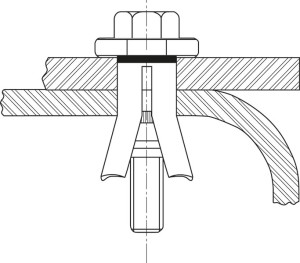
Figure 2. A proprietary expansion bolt for structural steel (drawing from the AISC Steel Construction Manual). Courtesy of American Institute of Steel Construction.
These expansion bolts are suitable for structural connections due to their capability to resist loading in both tension and shear. For example, the allowable load values for a ¾-inch diameter bolt are approximately 12,500 pounds for tension and 11,500 pounds for shear. Product sizes range from 5/16- to ¾-inch and the total material thickness clamping range is from 1/8-inch for the smallest diameter to 3-3/8-inch for the largest diameter.
An In-Depth Look at Expansion Bolts for Structural Steel
Early Product Developments
One of the first such fasteners to become widely available was a threaded stud expansion bolt, launched in the United Kingdom (UK) in 1948. This bolt was designed to provide a threaded stud that protruded from the HSS to provide an attachment point for lifting equipment during marine salvage operations. It was a success and, still available, remains a popular component within the offshore industry to this day.
Although initially developed in the 1950s, the widespread use of HSS did not start until the mid-1960s. Since then, its popularity has continued to increase, with many of today’s contemporary designs making a feature of exposed structural steel profiles to enhance the aesthetics of a building. During the 1980s, various shapes and sizes of HSS became available, and engineers needed a more versatile connection. This led to the development of a product in 1986 that had a fairly similar design to today’s expansion bolt. This product was a two-part assembly consisting of a slotted cylinder and cone, the latter threaded to receive a standard high-tensile fastener. While popular, system installation was not always easy; errors could arise when inserting the product into the tight ±0.008-inch tolerance hole. Working overhead and/or with the larger sizes of square and rectangular HSS, the required hammer blows could cause chord face flexure and spring-back, sometimes producing incorrect installation of the product and possible hole damage. The use of tools with tapered handles to align beam end plates and column hole centers during steelwork erection was restricted, as the product could easily be displaced.
Recent Product Developments
The knowledge gained from several decades of successful manufacture, combined with continuous direct contact with evolving on-site practices, formed the basis for the current expansion bolts designed to satisfy the needs of the steelwork erector in terms of ease and speed of installation. They also provide some tolerance to site abuse, for example hole size and misalignment, providing the construction industry with a robust yet aesthetically pleasing system. They are manufactured in carbon, alloy or stainless steel and are produced with a variety of finishes, meaning that they can be used in almost any situation: zinc-plated for standard use, hot-dip galvanized where a more robust product is needed, and stainless steel for the most demanding environments.
Expansion bolts have been continuously developed to meet the diverse requirements of structural engineers and architects. For example, there is now a flush fit head variant that leaves no protrusion above the surface of the steel section. Recent performance optimizations for structural connections include a patented mechanism that compresses during installation and provides a high clamping force, resulting in a more secure connection.
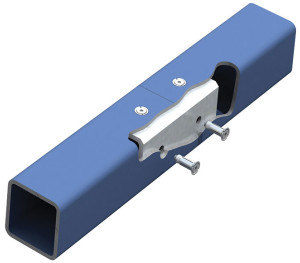
Figure 4. There are now many different types of expansion bolts such as this Flush Fit version, popular amongst architects.
Installation
Installing expansion bolts is relatively straightforward and requires only basic tools. The steel is pre-drilled with oversized holes, per the manufacturers’ literature, to accommodate the sleeve and cone-shaped nut. Care must be taken to ensure that the holes are located to allow the product to open within the HSS, meaning that they may not be placed closely together or near the edge. The steel can be fully prepared in the fabrication shop and transferred to site, where the advantage of fast installation can be fully appreciated. It is important to note that the faces of the members to be fastened together must be brought into contact before the expansion bolt is installed. To complete the process, the contractor must grip the expansion bolt collar with a wrench to prevent the body from rotating during installation and must tighten the central bolt to the manufacturer’s recommended torque using a calibrated torque wrench.
Limit States
As expansion bolts for structural steel are proprietary products, the manufacturer’s literature or code reports state the available strength for the expansion bolt itself. It is up to the designer to check the viability of the HSS member from the applied loads imposed on it by the fastener.
Per Design Guide 24, for expansion bolts in shear, the limit states for HSS are block shear, if near the end of the HSS, and bolt bearing. For tension applications, the limit states are distortion of the HSS wall and pull-out through the wall of the HSS.
Expansion bolts have been independently verified by various approval bodies around the world, including the International Code Council Evaluation Service (ICC-ES). Specifically, several expansion bolts have been approved by ICC-ES for compliance with the International Building Code to AC437, Acceptance Criteria for Expansion Bolts in Structural Steel. In order to gain this approval, these bolts were tested by an independent certified test laboratory, and the results were used to calculate capacities for both Load and Resistance Factor Design (LRFD) and Allowable Stress Design (ASD) methods under both tension and shear in line with the AISC Steel Construction Manual, 14th Edition.
Conclusion
As this article has shown, there are many options available for connecting to HSS. The designer or engineer will have to carefully select the most appropriate connection for their application. The relatively recent acceptance of HSS as a construction material, and subsequent increase in use for structural frames, has no doubt encouraged fastener manufacturers to concentrate their efforts on developing and improving innovative structural fasteners as a faster alternative to conventional methods such as through-bolting or welding. Likewise, the trend for construction developers and contractors to build structures in incredibly short timeframes has also contributed to an upsurge in demand for expansion bolts for structural steel, as it is specifically the speed of installation that is the fundamental benefit of this type of connection.

Figure 7. Expansion bolts secure the stunning HSS-framed roof at The Kimmel Center for the Performing Arts in Philadelphia.
When engineers are faced with a situation that requires a construction project to be completed within an extremely short timeline or if there are restrictions in welding, a designer will need to look at alternative connection methods. Expansion bolts for structural steel are now one of the best choices for making structural connections to HSS. With their capability to handle much higher loads than other single-sided fasteners, such as rivets, and the fact that they can be installed in the field using standard hand tools, unlike threaded studs, you may find yourself taking a serious look at expansion bolts for structural steel.▪

